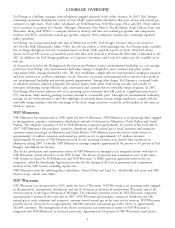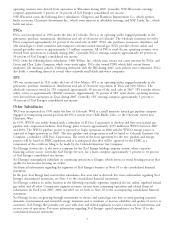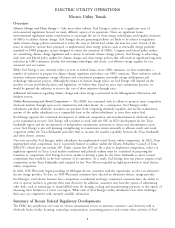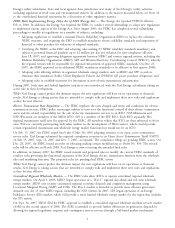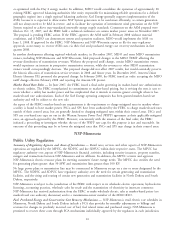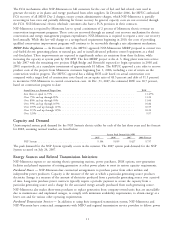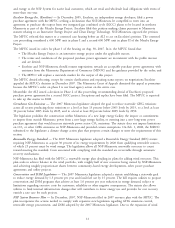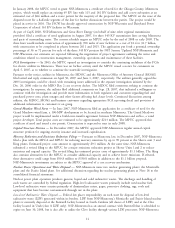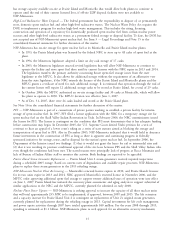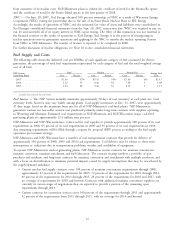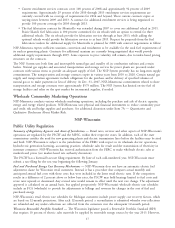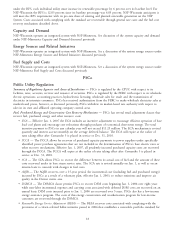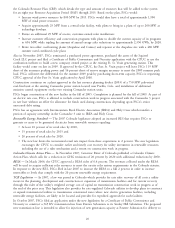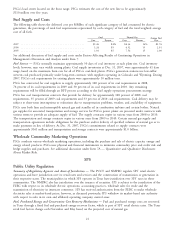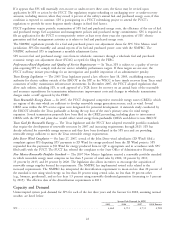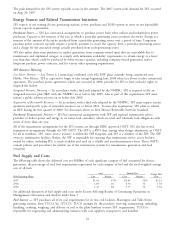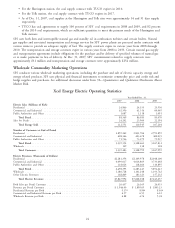Xcel Energy 2007 Annual Report Download - page 25
Download and view the complete annual report
Please find page 25 of the 2007 Xcel Energy annual report below. You can navigate through the pages in the report by either clicking on the pages listed below, or by using the keyword search tool below to find specific information within the annual report.has storage capacity available on-site at Prairie Island and Monticello that would allow both plants to continue to
operate until the end of their current licensed lives, if off-site LLW disposal facilities were not available to
NSP-Minnesota.
High-Level Radioactive Waste Disposal — The federal government has the responsibility to dispose of, or permanently
store, domestic spent nuclear fuel and other high-level radioactive wastes. The Nuclear Waste Policy Act requires the
DOE to implement a program for nuclear high-level waste management. This includes the siting, licensing,
construction and operation of a repository for domestically produced spent nuclear fuel from civilian nuclear power
reactors and other high-level radioactive wastes at a permanent federal storage or disposal facility. To date, the DOE has
not accepted any of NSP-Minnesota’s spent nuclear fuel. See Item 3 — Legal Proceedings and Note 15 to the
consolidated financial statements for further discussion of this matter.
NSP-Minnesota has on-site storage for spent nuclear fuel at its Monticello and Prairie Island nuclear plants.
• In 1993, the Prairie Island plant was licensed by the federal NRC to store up to 48 casks of spent fuel at the
plant.
• In 1994, the Minnesota legislature adopted a limit on dry cask storage of 17 casks.
• In 2003, the Minnesota legislature enacted revised legislation that will allow NSP-Minnesota to continue to
operate the facility and store spent fuel there until its current licenses with the NRC expire in 2013 and 2014.
The legislation transfers the primary authority concerning future spent-fuel storage issues from the state
legislature to the MPUC. It also allows for additional storage without the requirement of an affirmative vote
from the state legislature, if the NRC extends the licenses of the Prairie Island and Monticello plants and the
MPUC grants a certificate of need for such additional storage. It is estimated that operation through the end of
the current license will require 12 additional storage casks to be stored at Prairie Island, for a total of 29 casks.
• In October 2006, the MPUC authorized an on-site storage facility and 30 casks at Monticello, which will allow
the plant to operate to 2030. The MPUC decision was effective June 1, 2007.
• As of Dec. 31, 2007, there were 24 casks loaded and stored at the Prairie Island plant.
See Note 16 in the consolidated financial statements for further discussion of the matter.
PFS — NSP-Minnesota is part of a consortium of private parties working to establish a private facility for interim
storage of spent nuclear fuel. In 1997, PFS filed a license application with the NRC for a temporary storage site for
spent nuclear fuel on the Skull Valley Indian Reservation in Utah. In February 2006, the NRC commissioners issued
the license for PFS. The license is contingent on the condition that PFS must demonstrate that it has adequate funding
before construction may begin. In December 2005, the U.S. Supreme Court denied Utah’s petition for a writ of
certiorari to hear an appeal of a lower court’s ruling on a series of state statutes aimed at blocking the storage and
transportation of spent fuel to PFS. Also in December 2005, NSP-Minnesota indicated that it would hold in abeyance
future investments in the construction of PFS as long as there is apparent and continuing progress in federally
sponsored initiatives for storage, reuse, and/or disposal for the nation’s spent nuclear fuel. In September 2006, the
Department of the Interior issued two findings: (1) that it would not grant the leases for rail or intermodal sites and
(2) that it was revoking its previous conditional approval of the site lease between PFS and the Skull Valley Indian tribe
even though the conditions had been met. The stated reasons were principally lack of progress at Yucca Mountain and
lack of Bureau of Indian Affairs staff to monitor this activity. Both findings are expected to be appealed.
Prairie Island Steam Generator Replacement — Prairie Island Unit 2 steam generators received required inspections
during a scheduled 2005 outage. Based on current rates of degradation and available repair processes, NSP-Minnesota
plans to replace these steam generators in the 2013 refueling outage.
NSP-Minnesota Nuclear Plant Re-licensing — Monticello’s renewed license expires in 2030, and Prairie Island’s licenses
for its two units expire in 2013 and 2014. NRC approved Monticello’s renewed license in November 2006, and the
MPUC order approving additional spent fuel storage to support twenty additional years of operation went into effect
on June 1, 2007. Prairie Island has initiated the necessary plant assessments and aging analysis to support submittal of
similar applications to the NRC and the MPUC, currently planned for submittal in early 2008.
Nuclear Plant Power Uprates — NSP-Minnesota is seeking approval to increase the capacity of all three nuclear units
that will total approximately 235 MW, to be implemented, if approved, between 2009 and 2015. The life extension
and a capacity increase for Prairie Island Unit 2 is contingent on replacement of Unit 2’s original steam generators,
currently planned for replacement during the refueling outage in 2013. Capital investments for life cycle management
and power uprate activities through 2007 have totaled approximately $40 million. For the years 2008 through 2015,
spending is estimated at $1.1 billion. NSP-Minnesota plans to seek approval for an alternative recovery mechanism
15



